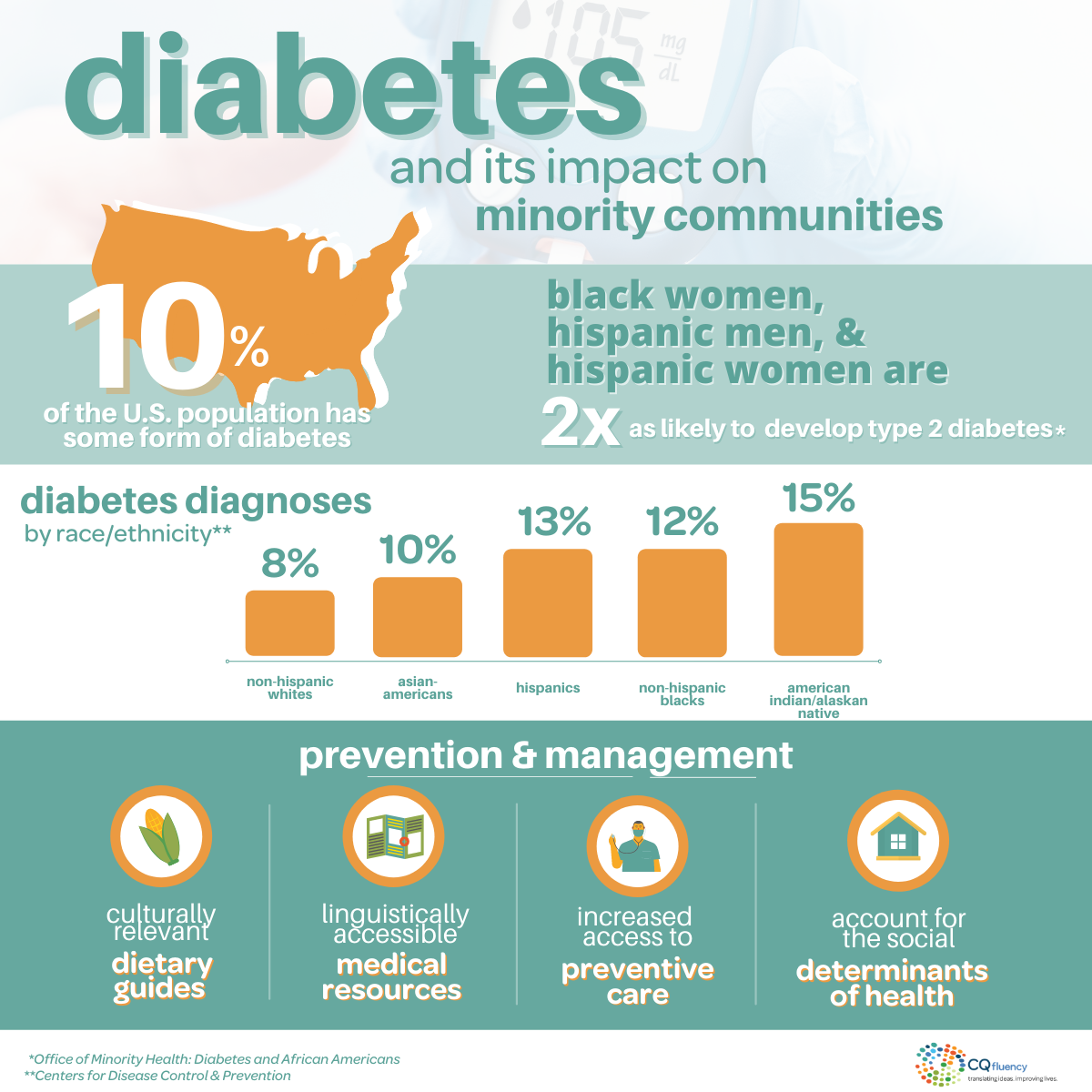bridging communication gaps in diabetes care
Although it affects people of all races and ethnicities, studies show that rates of diabetes diagnoses are significantly higher among ethnic minority groups. According to the CDC, of the almost 35 million diabetics in the U.S., Non-Hispanic Black Americans, Hispanics, Asian Americans, and American Indians/Alaskan Natives are disproportionately affected. While the disease can be managed, with prediabetes being reversible, with appropriate medications and lifestyle changes, it is critical to implement a framework of educational preparedness that is not only medically accurate, but culturally sensitive.
Effective education begins with communication and addressing potential barriers to understanding that can impact how a patient engages with their diabetes care. Miscommunication culminates from both language barriers, and cultural disconnects. Taking the time to gain a holistic understanding of a patients’ cultural profile prior to developing managed care plans or educational resources can foster a sense of trust between patient and provider. Additionally, taking into account factors such as low health literacy and level of English proficiency can guide educators in developing communication strategies that are not overly complex or linguistically inaccessible.

tips for culturally competent diabetes education
understand the social determinants of health
Understanding social barriers to care is critical to contextualize a patient’s specific situation. For years, ethnic minorities have been in receipt of lower quality care than their Non-Hispanic White counterparts.
Within the U.S., health disparities among these groups usually stem from lack of access to preventive care channels, socioeconomic status, food insecurity, unemployment or underemployment, age, and language/cultural barriers.
These factors represent a wider challenge of addressing social and racial inequalities in the U.S. – and globally – requiring a sustained effort from providers and health systems towards a more equitable, social and culturally oriented care model.
understand the cultural implications of health
Different cultures have their own perceptions of health, with certain diagnoses carrying more weight than others. For example, a type 2 diabetes diagnosis in many Hispanic communities is seen as a personal failing to manage one’s own health, and is heavily stigmatized, making individuals less likely to seek medical support. Additionally, an individual’s personal fears about treatment can have a direct impact on their adherence to care.
In some communities, there is a strong aversion to beginning insulin therapy. This is due to the negative connotations associated with it as being a ‘death sentence’, eventually culminating in life-altering complications. For example, insulin-induced blindness is a common myth perpetuated within these communities, creating hesitancy and genuine concern about starting insulin to manage their diabetes.
Another setback is the patient’s ability to identify the signs of the disease in relation to their own health. More than half of Asian Americans with diabetes may go undiagnosed because they often develop type 2 diabetes at a lower body mass index (BMI). Due to the link between diabetes and obesity being a common point of education, certain groups may not be aware of this ethnic nuance.
Understanding these concerns, the patient’s wider belief system, and the extent to which social stigma contributes to a patient’s capacity to pursue treatment can help inform appropriate patient-centric care, early interventions and treatment plans. Additionally, making culturally relevant, community-based educational resources readily available may help to thwart misinformation, dispel myths, and encourage appropriate preventive care.
consider the role of community
Cultural values are usually shared by close family, friends, and the wider community. In collectivist cultures, the family unit is often heavily engaged in the health and wellbeing of the patient. This dependence on close relatives and closer social circles commands respect from providers and educators, and engaging relatives in any medical activities, such as clinical education, consults and care plans can contribute greatly to the adherence and health outcomes of the patient.
For many Chinese patients, for example, there may be a reluctance to present with any mental or physical ailments, as the health of the individual is regarded as a reflection of the family, manifesting in feelings of shame or guilt. In the case of diabetes, culturally it is often seen as an early death sentence, creating added stigma from the family. Consulting with the patient and their relatives to understand the family dynamic, their health concerns and beliefs can help to reconcile these apprehensions and create a more optimistic view of treatment. Involving the relatives on this level also demonstrates an understanding of, and respect for, collective, family values.
adapt dietary guidelines
Diverse food traditions have often been under-represented in diabetic nutrition research and development, but recent studies are showing the value of incorporating a multicultural approach when developing dietary guidelines for diabetes prevention and management.
For example, instead of designing one-size-fits-all dietary guidelines to help manage diabetes, consider the staples and alternatives available and enjoyed across different cultures. There is huge dietary variation even within specific regions and sub-cultures which can be fully understood by proper engagement with the patient and their cultural profile. For example, if you are recommending a nutrition plan to a type 2 diabetic who enjoys a broadly Mexican diet, you could recommend incorporating more beans, tomatoes and avocado. For patients who follow a regional Chinese diet, recommend cooking meals with less oil, consuming healthier fats, such as fish, and incorporating high, soluble-fiber foods, such as taro, persimmon, and mung-beans.
Additionally, taking into account variation in nutritional behaviors, including linguistic differences, can help guide educators in creating the most culturally accurate materials. When developing Spanish language resources for diabetic nutrition, consider the linguistic variation of the same food types. Banana, for example, is referred to as ‘platano’ by Mexican Spanish speakers, ‘cambur’ by Venezualans, and ‘guineo’ by Puerto-Ricans. Once educators become familiar with these differences, it mitigates the risk of miscommunication with patients and demonstrates an appreciation for cultural diversity within specific language groups.
Furthermore, it may be beneficial for educators to connect with community resources who have a stronger understanding of specific cultural dietary behaviors to help encourage patients to make healthier choices in their day-to-day lives.
provide linguistically accessible resources
Ensuring linguistically accessible educational resources for diabetes prevention and management doesn’t simply mean translating from English into the target language. Many English medical resources can be filled with complex jargon that is not easily digestible by the average patient. When translating, it is important to factor in health literacy and the target audiences’ general capacity to understand basic health information.
Additionally, when developing these resources, it is critical that providers are factoring in linguistic nuances that may influence patients’ comprehension and engagement. Working with cultural experts to assess where adaptation of certain imagery, terminology or formatting is necessary helps to elevate the standard of multilingual medical resources for patients with limited English proficiency (LEP). This, in turn, enhances the quality and credibility of the information they receive.
Once these resources have been developed, ensuring they are readily accessible is crucial. Placing informative brochures in doctors’ offices, pharmacies, and managed care facilities is just one way to enhance accessibility. At the community level, educators can host free, multilingual information sessions in social hubs, or share infographics and educational pamphlets in frequently visited online spaces.

Empowering patients with the right information on diabetes prevention and management in a language they understand
At CQ fluency, we understand that multilingual communication is never a one-size-fits-all approach, especially when managing chronic conditions such as diabetes. That is why we adopt a culture-centric strategy to ensure your messaging is not just heard, but understood by the diverse markets you are trying to reach.
Contact us today to learn more about how you can lead the charge in preventing and effectively managing diabetes for your LEP patients, and how we can customize the right communication strategy or campaign for you.
